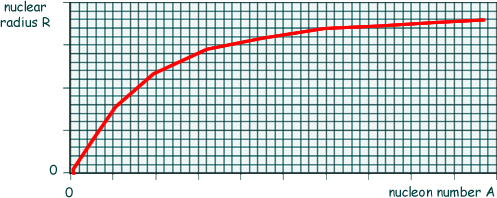(a) On the graph paper below sketch a graph to show how the radius, R, of a nucleus varies with its nucleon number, A.

You need to sketch a graph starting (steeply) near/at the origin and decreasing in gradient 
(b) The radius of a gold-197 nucleus  is 6.87 × 10–15 m.
is 6.87 × 10–15 m.
(i) Show that the density of this nucleus is about 2.4 × 1017 kg m–3.
mass = 197 x 1.67 x 10-27 = 3.29 x 10-25 kg
= 3.29 x 10-25 kg
volume = 4/3 (πr3) = 4π x (6.87 × 10–15)3 /3  = 1.39 x 10-42 m3
= 1.39 x 10-42 m3
density = mass/volume = 2.4 × 1017 kg m-3
(c) Nuclear radii have been investigated using α particles in Rutherford scattering experiments and by using electrons in diffraction experiments.
Make comparisons between these two methods of estimating the radius of a nucleus. Detail of any apparatus used is not required.
For each method your answer should contain:
the principles on which each experiment is based including a reference to an appropriate equation
an explanation of what may limit the accuracy of each method
a discussion of the advantages and disadvantages of each method
The quality of your written communication will be assessed in your answer.
Principles
α scattering involves coulomb or electrostatic repulsion
electron diffraction treats the electron as a wave having a de Broglie wavelength
some reference to an equation, for example λ = h/mv ; eV = mv2/2 ; Qq/4πεor = Eα ; sinθ = 0.61λ/R
reference to first minimum for electron diffraction
Accuracy
α-particles only measure the least distance of approach, not the radius
α-particle have a finite size which must be taken into account
 electrons need to have high speed/kinetic energy to have a small wavelength or wavelength comparable to nuclear diameter, the wavelength determines the resolution
electrons need to have high speed/kinetic energy to have a small wavelength or wavelength comparable to nuclear diameter, the wavelength determines the resolution
 the wavelength needs to be of the same order as the nuclear diameter for significant diffraction
the wavelength needs to be of the same order as the nuclear diameter for significant diffraction
 requirement to have a small collision region in order to measure the scattering angle accurately
requirement to have a small collision region in order to measure the scattering angle accurately
 importance in obtaining monoenergetic beams
importance in obtaining monoenergetic beams
 cannot detect alpha particles with exactly 180o scattering
cannot detect alpha particles with exactly 180o scattering
 need for a thin sample to prevent multiple scattering
need for a thin sample to prevent multiple scattering
Advantages and disadvantages
α-particle measurements are disturbed by the nuclear recoil
 mark for α-particle measurements are disturbed by the strong nuclear force when coming close to the nucleus or electrons are not subject to the strong nuclear force.
mark for α-particle measurements are disturbed by the strong nuclear force when coming close to the nucleus or electrons are not subject to the strong nuclear force.
 a second mark can be given for reference to strong nuclear force if they add electrons are leptons or alpha particles are hadrons.
a second mark can be given for reference to strong nuclear force if they add electrons are leptons or alpha particles are hadrons.
 α-particles are scattered only by the protons and not all the nucleons that make up the nucleus
α-particles are scattered only by the protons and not all the nucleons that make up the nucleus
 visibility – the first minimum of the electron diffraction is often difficult to determine as it superposes on other scattering events
visibility – the first minimum of the electron diffraction is often difficult to determine as it superposes on other scattering events


